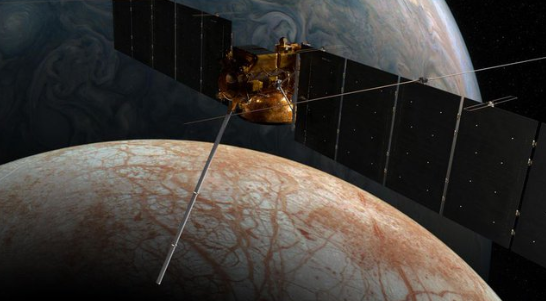The Europa Clipper spacecraft, set to launch in October 2024, is NASA’s ambitious mission to study Jupiter’s moon Europa, which is believed to have a subsurface ocean that could harbor life. The spacecraft will be equipped with nine advanced scientific instruments designed to explore the moon’s icy surface and analyze potential water plumes that may provide clues about the ocean beneath the ice. Europa Clipper is the largest spacecraft NASA has built for planetary exploration, measuring 16 feet tall with solar arrays spanning over 100 feet to capture enough sunlight in the dim environment near Jupiter.
Europa Clipper will perform at least 45 flybys of Europa, coming as close as 25 kilometers from the moon’s surface. During these flybys, it will gather data on the thickness of the ice shell, potential lakes under the surface, and the characteristics of the ocean, such as its depth and salinity. Scientists hope to better understand Europa’s habitability by studying its geology, chemistry, and the possibility of hydrothermal vents that might support life.
The spacecraft is designed to withstand the harsh radiation around Jupiter, with its sensitive electronics housed in a special vault. It will take six years to reach Jupiter, using gravity assists from Earth and Mars to make the journeyNASA’s Europa Clipper and Space Explore and Cosmos
NASA’s Europa Clipper spacecraft is on track for a historic launch next month, following a key milestone that ensures the mission is ready to proceed. With a launch window opening on October 10, Europa Clipper will embark on a journey to explore Jupiter’s moon Europa, a world that scientists believe could harbor the ingredients for life beneath its icy surface.
The mission’s approval to launch came after passing Key Decision Point E, a critical review stage. This milestone was especially important after the team discovered a potential issue in May related to the spacecraft’s transistors, components essential for controlling the flow of electricity. Engineers were concerned about whether these transistors could withstand Jupiter’s intense radiation environment. However, extensive testing at NASA facilities proved that the components could endure the harsh conditions.
⏰Time for #MoonHour™ Europa🧊 News.
🧊Cool news from NASA’s Europa Clipper mission!
It has successfully reached a significant milestone in its planning process, referred to as Key Decision Point E, on Monday. This grants the mission to move forward with preparations for its… pic.twitter.com/0t96FIJHDO— Diana🌜✨🔭 (@onlybeci) September 10, 2024
Jupiter, with its powerful magnetic field, bombards its moons with radiation, making it a challenging environment for spacecraft. Europa, one of Jupiter’s icy moons, orbits near the outer edge of the radiation belt, and any spacecraft exploring it needs to be equipped with radiation-hardened electronics. After months of around-the-clock testing, engineers concluded that the transistors would be able to “self-heal” after passing through the worst of Jupiter’s radiation, ensuring the spacecraft could complete its four-year mission of 49 flybys and 80 orbits.
With the radiation issue resolved, the Europa Clipper team is optimistic about the mission’s prospects. “We concluded that during our orbits around Jupiter, the transistors will heal and recover between flybys,” said Jordan Evans, Europa Clipper project manager. A radiation monitor on the spacecraft will allow the team to continuously assess the condition of its components throughout the mission.
Europa Clipper’s primary goal is to assess whether Europa has the necessary conditions to support life. Although it is not a life-detection mission, it will investigate whether the moon’s subsurface ocean contains the key ingredients for life, such as water, energy, and essential chemicals. Previous observations from NASA’s James Webb Space Telescope recently confirmed the presence of carbon on Europa’s surface, which may have originated from its vast ocean—potentially twice the volume of all of Earth’s oceans combined.
NASA’s Europa Clipper Mission Sets sfor launch on Oct 10 https://t.co/XvPnfkqDaT To Get all latest news and updates Join us on WHATSAPP group https://t.co/9JQObwuDqx https://t.co/Eb9Nz0m9u9 #
— News track English (@newstrack_eng) September 10, 2024
Scientists have long been fascinated by Europa’s potential to support life. Unlike Mars, which may have been habitable billions of years ago, Europa could be habitable today. Its vast ocean, hidden beneath a thick layer of ice, represents a new frontier in the search for life beyond Earth. If Europa Clipper’s investigations reveal that the necessary ingredients for life are present, NASA will likely prioritize future missions to directly search for signs of life.
“This mission is about understanding habitability, not finding life directly,” said Curt Niebur, Europa Clipper program scientist. However, if the mission confirms that Europa has the right conditions, it would prompt the search for life to intensify, not just on Europa but across our galaxy. “Think about what that means for the billions of other solar systems out there,” added Niebur.
Europa Clipper’s findings could revolutionize our understanding of where life might exist beyond Earth. If Europa is confirmed to have the conditions necessary for life, it would mark a significant breakthrough in humanity’s quest to understand the potential for life in the universe.
Key Points:
i. NASA’s Europa Clipper spacecraft passed a key milestone and is set to launch in October to explore Jupiter’s moon Europa, which may harbor the ingredients for life.
ii. The mission overcame concerns about radiation-hardened transistors on the spacecraft, which are essential for surviving Jupiter’s harsh environment.
iii. The spacecraft will conduct 49 flybys of Europa and 80 orbits around Jupiter during its four-year mission, searching for signs of habitability beneath Europa’s icy surface.
iv. Recent observations confirmed the presence of carbon on Europa, signaling a potentially habitable environment in its subsurface ocean.
v. Europa Clipper’s mission will assess whether Europa has the necessary conditions to support life, potentially paving the way for future missions to search for life directly.
Conner T – Reprinted with permission of Whatfinger News

